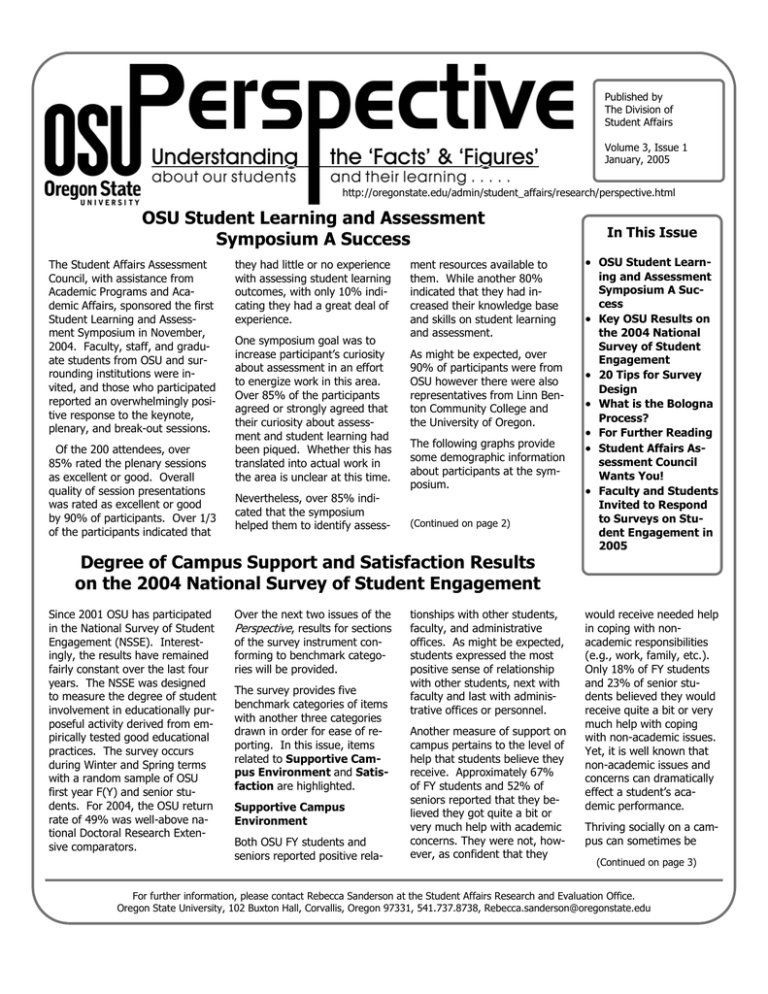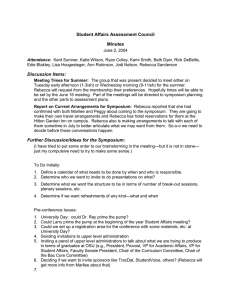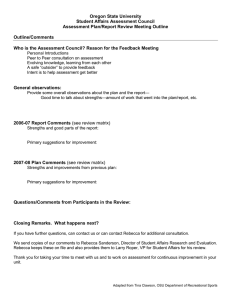Document 13325509
advertisement

Published by The Division of Student Affairs Volume 3, Issue 1 January, 2005 http://oregonstate.edu/admin/student_affairs/research/perspective.html OSU Student Learning and Assessment Symposium A Success The Student Affairs Assessment Council, with assistance from Academic Programs and Academic Affairs, sponsored the first Student Learning and Assessment Symposium in November, 2004. Faculty, staff, and graduate students from OSU and surrounding institutions were invited, and those who participated reported an overwhelmingly positive response to the keynote, plenary, and break-out sessions. Of the 200 attendees, over 85% rated the plenary sessions as excellent or good. Overall quality of session presentations was rated as excellent or good by 90% of participants. Over 1/3 of the participants indicated that they had little or no experience with assessing student learning outcomes, with only 10% indicating they had a great deal of experience. One symposium goal was to increase participant’s curiosity about assessment in an effort to energize work in this area. Over 85% of the participants agreed or strongly agreed that their curiosity about assessment and student learning had been piqued. Whether this has translated into actual work in the area is unclear at this time. Nevertheless, over 85% indicated that the symposium helped them to identify assess- ment resources available to them. While another 80% indicated that they had increased their knowledge base and skills on student learning and assessment. As might be expected, over 90% of participants were from OSU however there were also representatives from Linn Benton Community College and the University of Oregon. The following graphs provide some demographic information about participants at the symposium. (Continued on page 2) Degree of Campus Support and Satisfaction Results on the 2004 National Survey of Student Engagement Since 2001 OSU has participated in the National Survey of Student Engagement (NSSE). Interestingly, the results have remained fairly constant over the last four years. The NSSE was designed to measure the degree of student involvement in educationally purposeful activity derived from empirically tested good educational practices. The survey occurs during Winter and Spring terms with a random sample of OSU first year F(Y) and senior students. For 2004, the OSU return rate of 49% was well-above national Doctoral Research Extensive comparators. Over the next two issues of the Perspective, results for sections of the survey instrument conforming to benchmark categories will be provided. The survey provides five benchmark categories of items with another three categories drawn in order for ease of reporting. In this issue, items related to Supportive Campus Environment and Satisfaction are highlighted. Supportive Campus Environment Both OSU FY students and seniors reported positive rela- tionships with other students, faculty, and administrative offices. As might be expected, students expressed the most positive sense of relationship with other students, next with faculty and last with administrative offices or personnel. Another measure of support on campus pertains to the level of help that students believe they receive. Approximately 67% of FY students and 52% of seniors reported that they believed they got quite a bit or very much help with academic concerns. They were not, however, as confident that they In This Issue • OSU Student Learn- • • • • • • ing and Assessment Symposium A Success Key OSU Results on the 2004 National Survey of Student Engagement 20 Tips for Survey Design What is the Bologna Process? For Further Reading Student Affairs Assessment Council Wants You! Faculty and Students Invited to Respond to Surveys on Student Engagement in 2005 would receive needed help in coping with nonacademic responsibilities (e.g., work, family, etc.). Only 18% of FY students and 23% of senior students believed they would receive quite a bit or very much help with coping with non-academic issues. Yet, it is well known that non-academic issues and concerns can dramatically effect a student’s academic performance. Thriving socially on a campus can sometimes be (Continued on page 3) For further information, please contact Rebecca Sanderson at the Student Affairs Research and Evaluation Office. Oregon State University, 102 Buxton Hall, Corvallis, Oregon 97331, 541.737.8738, Rebecca.sanderson@oregonstate.edu Page 2 Symposium (Continued from page 1) 20 Tips for Survey Design Symposium Participant’s Years at Institution Submitted by Molly Engle Office of Academic Programs 40 35 30 25 % 20 15 10 5 0 Less than one year 1-5 years 6-10 years 11 or more years Symposium Participant’s Rank at Institution O th e r U n d e r g r a d u a te S tu d e n t P r o fe s s o r P r o f e s s io n a l F a c u lt y In s t r u c t o r G r a d u a te S tudent G R A /G T A /G A C la s s if ie d A s s o c ia te P r o fe s s o r A s s is ta n t P r o fe s s o r 60 50 40 % 30 20 10 0 For those who were unable to attend the OSU Student Learning and Assessment Symposium, the keynote address and plenary sessions by both Dr. Peggy Maki and Dr. Marilee Bresciani are posted on the web until the end of June. Additionally, resources distributed at the symposium have been posted on the web and can be downloaded for review. In order to access information about the symposium including evaluation information, go to: http://oregonstate.edu/admin/student_affairs/research/ assess_symposium/index.php Deciding to use a survey to gather information about students or other patrons of your service, class, program, etc. initiates a process of survey development and design. This article will focus only on the design of the survey instrument. Further information about survey development, writing questions, decisionmaking about whether or not a survey is an appropriate methodology to answer your questions can be found in a variety of manuals. A listing of other resources can be found at the end of this article. While some problems with surveys come from question wording, others arise because of question format, question order, or the appearance of individual questions or pages. Decisions must be made about page size, page binding, order of questions, and graphical aspects of layout such as spacing, size, and brightness. Good survey design really has two major objectives: (1) to reduce non-response; and (2) to reduce or avoid measurement error. Design features are intended to motivate people to respond, by making the survey easy to use and answer, and to build trust though attention to detail lending an air of importance to the survey. The following tips for survey design are taken from Mail and Internet Surveys: The Tailored Design Method 2nd Edition As participants have told us, the information on the web site was: by D. A. Dillman (2000). For more complete information about each tip, please refer to Dillman’s book. For ease of reference, page numbers for Dillman (2000) are provided after each tip. 45 40 35 30 25 20 15 10 5 0 Tips: Excellent Good Fair Poor Not Applicable/No Opinion 1. Keep it simple. 2. Use a booklet format, as two-sided (Continued on page 4) For further information, please contact Rebecca Sanderson at the Student Affairs Research and Evaluation Office. Oregon State University, 102 Buxton Hall, Corvallis, Oregon 97331, 541.737.8738, rebecca.sanderson@oregonstate.edu Page 3 2004 National Survey of Student Engagement (Continued from page 1)) problematic for some students. Again, both FY (30%) and senior students (23%) had less confidence that they would receive quite a bit or very much help to thrive socially. Even though there are a tremendous number of student organizations on campus, many students do not seem to see them as a means to a social network. Satisfaction at OSU A little over one-fifth of OSU FY and senior students reported that they had received excellent academic advising. Mean scores for both seniors and FY students were in the fair to good range. A little over one-third of OSU FY and senior students indicated that if they could start all over again, they would definitely still enroll at OSU. Another 49% of FY and 46% of seniors indicated that they probably would enroll at OSU again. Of concern were the 4% of FY students and the 4% of seniors who indicated that they would definitely not go to OSU again if given the choice. Nevertheless, 80% of FY students and 83% of seniors evaluated their educational experience as good or excellent. In the next issue, results on Level of Academic Challenge and Student Interactions with Faculty Members will be featured. For further information on the OSU results on NSSE, please contact: Dr. Rebecca A. Sanderson, Director of Student Affairs Research and Evaluation, 541-737-8738, Rebecca.sanderson@oregonstate.edu. For information about NSSE consult: http://www.indiana.edu/~nsse/. What is the Bologna Process? In a recent article in the NovemberDecember, 2004, Assessment Update, Dr. Peter Ewell proposes that in the next decade the European Union may surpass the U. S. in realizing a vision of higher education “accountability based on learning outcomes” and alignment across nations and institutions. The Bologna process, which began in 1999, was an initiative of the European Union (EU) and was begun in order to create “a European higher education area within which the comparability and competitiveness of postsecondary credentials would be assured.” Not unlike processes in the U.S., this initiative was undergirded by the beliefs of policy makers that higher education was the key to economic and global success. In 2000 “EU heads of state set the goal of making Europe the most competitive and dynamic knowledge-based economy in the world.” As this process in the EU has continued, it has fueled conversations by educators focused on “(1) adoption of a system of easily readable and comparable degrees based on a common framework of degree levels, (2) evolution of a credit-based system to facilitate international transfer, and (3) development of a cooperative system of quality assurance.” This Bologna Declaration has guided a process in the EU in which student learning outcomes are playing a major role in developing aligned outcomes implemented on an institution-by-institution bases. For more information about the Bologna process and the Bologna Declaration, consult: Ewell, P.T. (2004). Tomorrow the world: Learning outcomes and the Bologna process. Assessment Update, 16(6), p. 11-13. Web resource: http://www.coe.int/t/e/cultural_cooperation/education/higher_education/ activities/bologna_process/ an_overview_of_the_Process.asp Perhaps U.S. colleges and universities can learn from our European colleagues about ways of focusing discussions on student learning outcomes rather than just on credits hours earned. For Further Reading Association of American Colleges and Universities. (2004). Our students’ best work: A framework for accountability worthy of our mission. Washington, D. C.: AAC & U. Ewell, P. T. (2004). Tomorrow the world: Learning outcomes and the Bologna process. Assessment Update, 16(6), 11-13. Greater Expectations National Panel. (2002). Greater expectations: A new vision for learning as a nation goes to college. Washington, D. C.: AAC & U. Suskie, L. A. (1996). Questionnaire survey research: What works. Tallahassee, FL: Association for Institutional Research. Student Affairs Assessment Council Wants YOU! As many of you know, the Student Affairs Assessment Council was busy last summer and fall with the planning and implementation of the OSU Student Learning and Assessment Symposium. During the next couple of weeks, we will be setting our agenda for the remainder of the year. This includes educational opportunities, review of Student Affairs assessment plans, and conversations around our contributions to the learning and success of students. Please know that you are invited to join this energetic, thoughtful, and committed group of faculty and staff! For information about meeting times and locations, refer to: http:// oregonstate.edu/admin/student_ affairs/research/res_introduction.html For further information, please contact Rebecca Sanderson at the Student Affairs Research and Evaluation Office. Oregon State University, 102 Buxton Hall, Corvallis, Oregon 97331, 541.737.8738, Rebecca.sanderson@oregonstate.edu Page 4 Faculty and Students Invited to Respond to Surveys on Student Engagement in 2005 20 Tips on Survey Design (Continued from page 2) formats, unusual folds, and odd shapes reduce responses (82). 17. List answer categories vertically instead of horizontally (121). 3. Group questions by topic from most important to least important. Place sensitive questions (e.g., income, class, etc.) near the end of the survey (86). 18. Maintain consistent spacing between answer choices (127). 4. Write each question as simply as possible to avoid the need to re-read portions in order to answer the question (97). 5. Place instructions exactly where needed rather than all at the beginning of the questionnaire (98). 6. Ask one question at a time (100). 7. Place items with the same response categories in the same section (100). 8. Use visual navigation guides to help the reader move through the survey (105). 19. Use shorter lines to prevent words from being skipped (129). 20. Contact the Office of Academic Programs (737-8083, 737-8246) for assistance in constructing survey questionnaires and advice about survey design. Additional resources, other than those listed below, for survey development and design can be found in the “For Further Reading” section of this newsletter. References Dillman, D. A. (2000). Mail and internet surveys: The tailored design method (2ed.). New York: John Wiley & Sons, Inc. 9. Use increased font size and/or increased brightness to attract the reader’s attention (106). Fink, A. (ed.) (1995). The survey kit. Thousand Oaks, CA: Sage Publications. 10. Use space to identify appropriate groupings (108). Fowler, F. J. (1995). Improving survey questions: Design and evaluation. Applied Social Research Methods Series, vol. 38. Thousand Oaks, CA: Sage Publications. 11. Maintain simplicity, regularity, and symmetry to make the response task easier (109). 12. Use the brightest or largest symbols to identify the starting point on each page (114). 13. Identify the beginning of each succeeding question in a consistent way (115). 14. Number questions consecutively and simply from beginning to end (115). 15. Place more blank space between questions than between subcomponents of questions (117). 16. Use dark print for questions and light print for answer choices (118). Fowler, F. J. (1988). Survey research methods. Applied Social Research Methods Series, vol. 1. Thousand Oaks, CA; Sage Publications. Lavrakas, P. J. (1987). Telephone sur- vey methods: Sampling, selection, and supervision. Applied Social Re- search Methods Series, vol. 7. Thousand oaks, CA: Sage Publications. Rea, L. M. & Parker, R. A. (1992). De- signing and conducting survey research: A comprehensive guide. San Francisco: Jossey-Bass. Salant, P. & Dillman, D. A. (1994). How to conduct your own survey. New York: John Wiley & Sons, Inc. During the 2005 Winter and Spring Terms, OSU will participate in the National Survey of Student Engagement (NSSE) and the Faculty Survey of Student Engagement (FSSE). The project will be administered by the Division of Student Affairs with the endorsement, funding, and support of the Interim Vice Provost for Academic Affairs and International Programs, Dr. Becky Johnson. Since 2002, OSU has participated in the NSSE surveys of first year (FY) and senior (SR) students regarding their participation in educationally purposeful activities. The FSSE was constructed to parallel the NSSE, and is designed to obtain information from college/university faculty across the nation about the ways in which they involve undergraduate students in good educational practices, both inside and outside the classroom. Faculty teaching at least one undergraduate course during the 2004-05 academic year will be invited to participate. OSU Perspective: What is it? The OSU Perspective was developed to provide assessment and other information about our students and programs. We have also from time to time published articles designed to provide to the readership opportunities for further education about assessment. We hope that by making this information available to OSU faculty and staff, we can stimulate conversation that helps keep students and student learning at our core. The Perspective is published quarterly both in print and on the web: http:// oregonstate.edu/student_affairs/research/ perspective.html Ideas and suggestions for subsequent OSU Perspective publications are welcomed. Please contact Rebecca Sanderson, Ph.D., Student Affairs Research and Evaluation Office, 102 Buxton Hall, 541-737-8738, or email: rebecca.sanderson@oregonstate.edu. Editorial assistance provided by Jodi Nelson, Office of the Vice Provost for Student Affairs. For further information, please contact Rebecca Sanderson at the Student Affairs Research and Evaluation Office. Oregon State University, 102 Buxton Hall, Corvallis, Oregon 97331, 541.737.8738, rebecca.sanderson@oregonstate.edu

